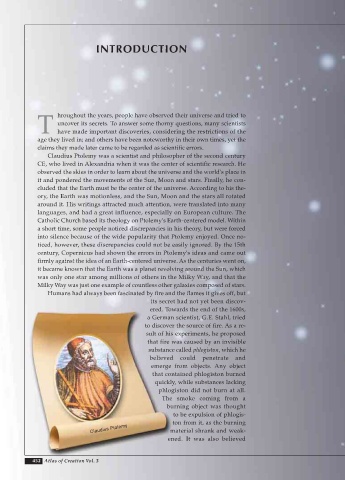Page 454 - Atlas of Creation Volume 3
P. 454
INTRODUCTION
hroughout the years, people have observed their universe and tried to
uncover its secrets. To answer some thorny questions, many scientists
T have made important discoveries, considering the restrictions of the
age they lived in; and others have been noteworthy in their own times, yet the
claims they made later came to be regarded as scientific errors.
Claudius Ptolemy was a scientist and philosopher of the second century
CE, who lived in Alexandria when it was the center of scientific research. He
observed the skies in order to learn about the universe and the world's place in
it and pondered the movements of the Sun, Moon and stars. Finally, he con-
cluded that the Earth must be the center of the universe. According to his the-
ory, the Earth was motionless, and the Sun, Moon and the stars all rotated
around it. His writings attracted much attention, were translated into many
languages, and had a great influence, especially on European culture. The
Catholic Church based its theology on Ptolemy's Earth-centered model. Within
a short time, some people noticed discrepancies in his theory, but were forced
into silence because of the wide popularity that Ptolemy enjoyed. Once no-
ticed, however, these discrepancies could not be easily ignored. By the 15th
century, Copernicus had shown the errors in Ptolemy's ideas and came out
firmly against the idea of an Earth-centered universe. As the centuries went on,
it became known that the Earth was a planet revolving around the Sun, which
was only one star among millions of others in the Milky Way, and that the
Milky Way was just one example of countless other galaxies composed of stars.
Humans had always been fascinated by fire and the flames it gives off, but
its secret had not yet been discov-
ered. Towards the end of the 1600s,
a German scientist, G.E. Stahl, tried
to discover the source of fire. As a re-
sult of his experiments, he proposed
that fire was caused by an invisible
substance called phlogiston, which he
believed could penetrate and
emerge from objects. Any object
that contained phlogiston burned
quickly, while substances lacking
phlogiston did not burn at all.
The smoke coming from a
burning object was thought
to be expulsion of phlogis-
ton from it, as the burning
Claudius Ptolemy material shrank and weak-
ened. It was also believed
452 Atlas of Creation Vol. 3

